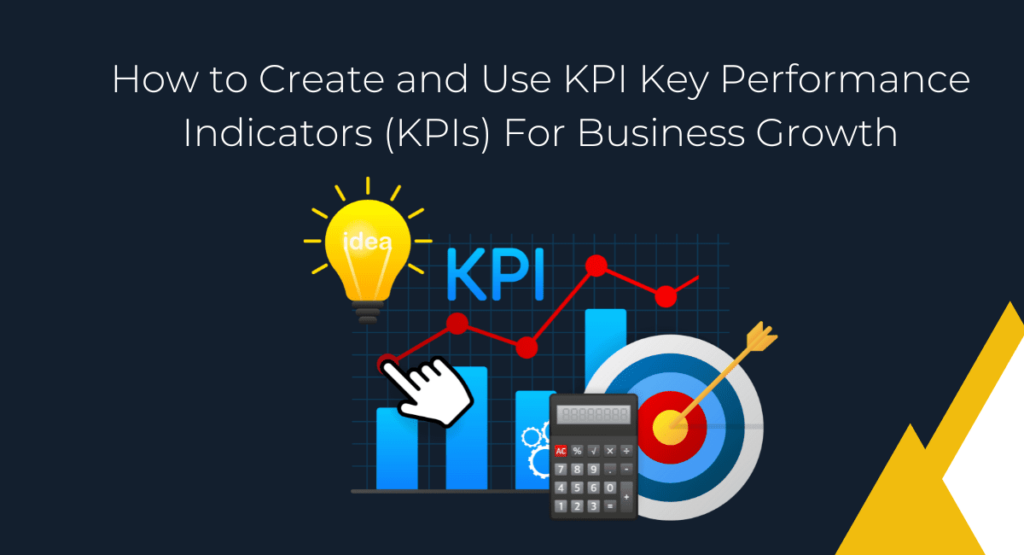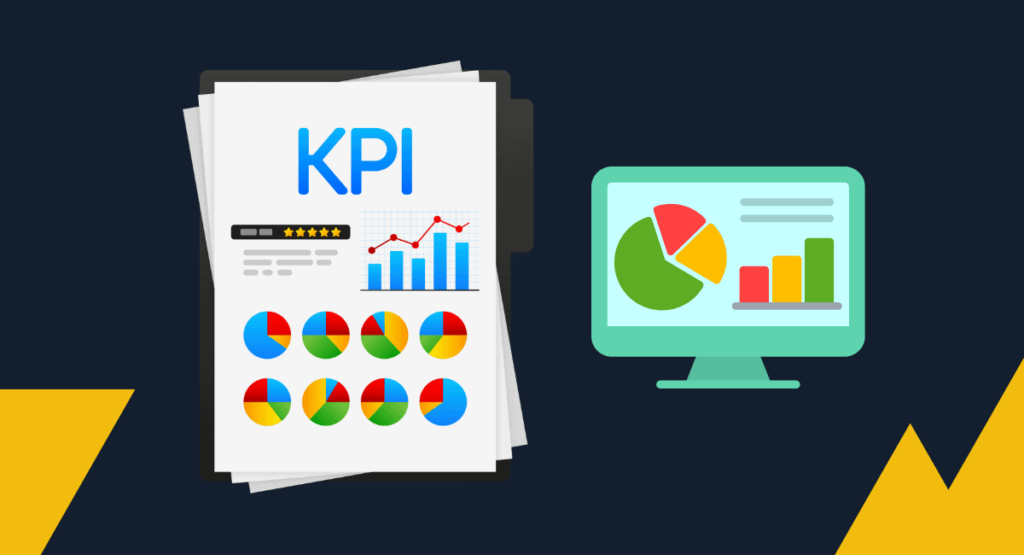How to Create KPI’s for Your Team


A key performance indicator is a metric that you use to track and measure the progress of your team or business.
It is important to create KPIs relevant to your specific business and track them regularly to make data-driven decisions about where your business should be heading.
This blog post will discuss how to create effective KPIs and use them for maximum growth potential!
What is a KPI, and why should you use them?
“3 Features every Key Performance Indicator board must have to make team accountability 10X easier: Names (who), Number (what), Dates (when).” Ayo Phillips
A KPI is a measurable value on how effectively the company achieves key business objectives.
KPIs are typically used to track progress and performance over time and sometimes custom to specific business goals. Examples include financial KPIs, organizational efficiency, customer satisfaction, and employee engagement.
By tracking the right KPIs, businesses can make better-informed decisions about where to allocate resources and how to improve their overall performance. When selecting KPIs, it is essential to choose metrics relevant to the company’s specific business goals so that it can accurately measure performance indicators.
Otherwise, the KPI will not be an effective tool for tracking progress or identifying areas for improvement.
Why should you use KPI?
KPIs, or key performance indicators, are essential for any business. KPIs provide a way to measure progress and identify areas of improvement.
High-level management can make informed decisions about utilizing the company’s resources and improving operations by tracking KPIs. The company can use KPIs to track progress toward objectives, measure customer satisfaction, or assess the performance of employees.
When used correctly, KPIs can provide invaluable insights into the health of a business. For any business looking to improve operations and drive growth, KPIs are an essential tool.
Get more out of your business
Get the best employee engagement content every week via mailing list
How to create a KPI for your business?

Setting and measuring key performance indicators (KPIs) is essential when running a successful business. KPIs help you to track progress towards strategic goals and identify areas of improvement. But how do you go about creating a KPI for your business?
Significant points to keep in mind when creating a KPI:
- KPIs align with the company’s business goals.
- It should be measurable.
- It should be actionable, meaning that you can take steps to improve it.
One common mistake businesses make is using too many KPIs. KPI should focus on a few key indicators that will give you the most insights into your business’s performance. Trying to measure everything can quickly become overwhelming and bog down your team.
Another mistake is setting unrealistic goals. Your KPIs should challenge you to improve, but they shouldn’t be impossible to reach. Otherwise, you’ll end up discouraged.
When used correctly, KPIs are a powerful tool for business growth. Creating strategic, actionable, and measurable KPIs ensures the business is on the right track to reach its goals.
1. Define the business goal
The first step in creating a KPI is to define the business goal. It will help you track. What is it that you want to achieve? Do you want to increase sales, reduce costs, or improve customer satisfaction? Once you’ve decided on a goal, you can begin to select KPIs that will help you measure progress toward that goal.
For instance, if the company goal is to increase revenue, you might track KPIs such as website traffic, conversion rate, or average order value. You might track KPIs such as customer churn rate or employee turnover rate to reduce costs.
No matter what goal you’re trying to achieve, a KPI can help you measure progress.
2. Select the right KPI
Once you’ve defined your business goal, it’s time to select the right KPI. The KPIs at least follow these steps:
First, the KPI should be relevant to your business goal. You won’t want to track website traffic if you’re trying to increase sales.
Second, the KPI should be measurable. Measurable means that you should be able to track and interpret the data.
And third, the KPI should be actionable. The actionable means that you can take steps to improve it.
If your goal is to improve customer satisfaction, a relevant KPI might be the Net Promoter Score. You can easily measure this metric, and there are actions you can take to improve it.
3. Track progress
Once you’ve selected the right KPI, it’s time to start tracking. The tracking helps you measure progress toward your goal. When tracking a KPI, you should notify some crucial points:
First, you need to establish a baseline. The baseline is the starting point from which you’ll track progress.
Second, you need to set the goal you’re trying to reach.
And third, you need to track progress over time to identify trends and areas of improvement.
How to use KPIs to make data-driven decisions for your business

As a business owner, data is key to making informed decisions about your company’s future. But with so much data available, it can be hard to know where to start. That’s where key performance indicators (KPIs) come in.
KPIs are specific, measurable values that help you track progress toward critical goals. By selecting suitable KPIs and monitoring them closely, you can gain valuable insights into your business and make data-driven decisions that will help your company grow.
There are two types of KPIs: leading indicators and lagging indicators.
- Leading indicators are values that predict future performance, such as customer satisfaction or website traffic.
- Lagging indicators are values that reflect past performance, such as sales numbers or profit margins.
There are several different KPIs that you can use, including customer satisfaction rates, return on investment (ROI), and employee retention rates.
Tracking these KPIs allows you to review how your business performs and decide where to focus your efforts. In addition, KPIs can also help you identify trends and areas of opportunity that you may not have been aware of.
By tracking both types of KPIs, you can get a well-rounded view of your business and identify areas for improvement.
Selecting suitable KPIs can be challenging, but a few key factors are to consider.
Think about the business goals you want to achieve with your KPI tracking. Then choose KPIs that are relevant to your industry and business goals. And finally, make sure that your KPIs are measurable and achievable.
Once you’ve selected the right KPIs for your business, you can use them to make data-driven decisions that will help your company thrive.
The benefits of using KPIs in your business
If you’re looking to improve your business, use the key performance indicators. KPIs can help you track your progress and identify areas you need to improve. They can also help you benchmark your performance against other businesses in your industry.
You can use several KPIs, but some of the most common include net profit margin, customer satisfaction levels, and employee turnover rate. You can see your business’s performance and where you need to make changes by tracking these indicators.
Using KPIs can be extremely helpful in growing your business. They provide valuable data that the company can use to make informed decisions about where to focus its efforts. If you’re not already using KPIs, now is the time to start. You’ll be glad you did.
Examples of KPIs that you can use in various businesses
Here are some samples of KPIs:
- A manufacturing business’s KPIs might include production costs, quality control measures, and employee productivity.
- A retail business’s KPIs might include sales figures, customer satisfaction levels, and return on investment (ROI).
- In a service-based business, KPIs might include customer retention rates, customer satisfaction levels, and employee satisfaction levels.
- In Sales Department, the KPI could be
Sales revenue
Monthly conversion rates
Profit margin
Customer satisfaction ratings
Customers retention rate
- In the Human Resources Department, KPIs could be
Employee satisfaction ratings
Employee retention rates
Training and development programs’ effectiveness
- In the Marketing Department, KPIs could be
Website Traffic
Social media engagement
Lead conversion rates
Sales revenue
A business focused on growth might choose to track KPIs such as website traffic, social media engagement, and lead conversion rates.
Tracking KPI Key Performance Indicator

How to get started with KPI tracking: you’re new to KPI tracking, the process can seem daunting. But it doesn’t have to be. Here’s a quick overview of how to get started:
1. Select the KPIs that you want to track.
As mentioned above, there are many different KPIs to choose from. But it’s crucial to select the ones that are most relevant to your business goals.
2. Set up a system for tracking your KPIs.
We can format the business KPIs by using a spreadsheet or KPI software.
3. Collect data for your KPIs.
This data can come from various sources, including financial reports, customer surveys, and employee performance reviews.
4. Analyze your KPI data.
Once you have collected data for your KPIs, it’s time to start analyzing it. The analysis will help you identify trends and patterns that the company can use to improve your business.
5. Use your KPI data to make informed decisions.
The whole point of tracking KPIs is to use the data to make better decisions about your business. KPI data can improve your marketing strategies, optimize your operations, and more.
KPI tracking can seem like a lot of work. But it’s worth it. KPIs provide valuable data that the company can use to improve your business. So if you’re not already tracking KPIs, now is the time to start. You’ll be glad you did.
10 Best practices for effective measurement with KPIs
Companies can measure the KPIs of their employees in regular periods, Quarter-Semi, and Final on annual reviews. The effective measure performance of KPIs can do as follows:
1. Keep it simple.
The KPI should be easily understandable by everyone on the team. It should be brief, clear, and to the point.
2. Make it actionable.
The KPI should be something that the team can act on and improve. A KPI that is not actionable is not very useful.
3. Make it measurable.
The KPI should be something that the company can measure objectively. The measurement means there should be a straightforward way to track progress and determine whether the KPI is achievable.
4. Set a realistic goal.
The KPI should be achievable but challenging. If the goal is too easy, the KPI will not be meaningful. If the goal is too difficult, the KPI may be discouraging.
5. Review and adjust regularly.
The company should review the KPI regularly to ensure it is still relevant and actionable. The team may need to make adjustments as their goals and priorities change.
6. Communicate the KPI to everyone on the team.
Everyone on the team should know the KPI and what it represents. The KPIs will ensure that everyone is working on the same goal.
7. Make sure to align the KPI with the company’s strategy.
The KPI should support the company’s overall strategy. It should not be a standalone goal unrelated to the company’s overall objectives.
8. Use data to drive decision-making.
The KPI should be used to inform decision-making. The company should analyze data regularly to ensure that the KPI is effective and achieves the desired results.
9. Be prepared to change the KPI.
The KPI may need to be changed over time as the team’s goals and priorities change. Be prepared to adjust the KPI to ensure it remains relevant and actionable.
10. Celebrate progress.
Celebrating progress when the team meets or exceeds the KPI is important. Team celebration will help motivate the team and keep them focused on meeting the KPI.
The companies should have KPI dashboards to monitor the progress of the whole KPIs organization.
Conclusion
By tracking the right performance metrics, you can identify which areas of your business need improvement. Use KPIs to set targets and measure your success in reaching them.
A KPI is a metric that measures progress toward specific goals. There are different types of KPIs depending on what area of your business you want to track.
The most crucial part is ensuring that you select the right performance metrics for the company. By tracking the right performance metrics, you can identify which areas of your business need improvement to help your business grow.


